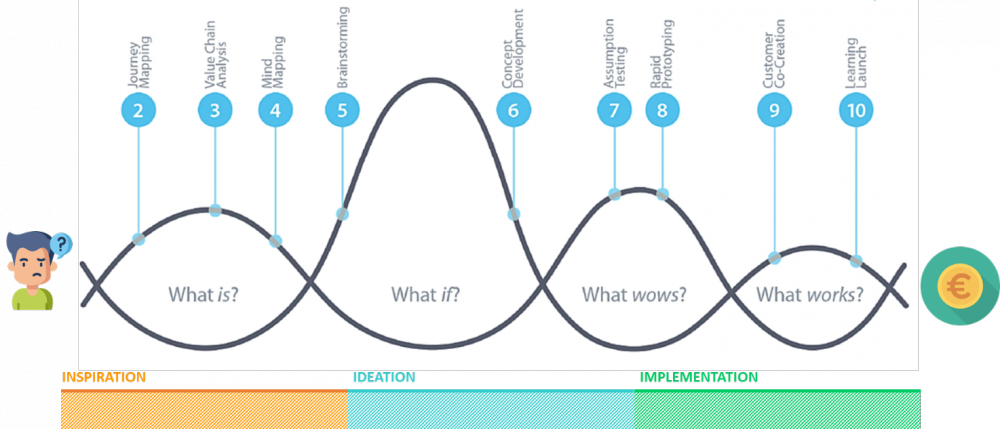The Fable of the Eureka Moment
Possibly the most common (and misleading) view of innovation and the creative process is referred to as the “Eureka Moment”. In this short-sighted view, innovation happens as a miracle when a special person achieves a breakthrough or is suddenly struck by a moment of brilliance. Apple’s first iPhone is a classic example of such a radical breakthrough being attributed to the brilliance of a few great minds. There are numerous other cases, but the message stays the same: innovation takes a special gift, one that most people just do not have.
Fortunately, for organizations and individuals, this just is not true. Throughout history there have been some people that were labelled as geniuses by some, like Elon Musk, Steve Jobs or Mark Zuckerberg, who shaped our society in different ways. However, genius is not the only path to innovation, and believing the “Eureka” fable undermines executives and employee’s confidence in their own abilities. As always, there is a different side to the story.
(Un)tangled with Design Thinking
Another common idea is that innovation is a black box; a never-ending tangle of concepts and hypotheses. Here, the ability to think creatively is a mysterious force that is only entitled to a special group of people. In contrast with this vision, rather than waiting for the “Eureka” moment, the effort should be focused on understanding how to untangle the mysteries of innovation and create real value. By analyzing the creative process, in the below diagram adapted from Jeanne Liedtka “Design for Growth”, the tangle evolves into a systematic series of questions.

Creative Process, adapted from Jeanne Liedtka’s “Design for Growth”
What Is?
The first of these questions is “What is?” and explores the current reality. Every successful innovation begins with a precise review of the present state. Starting out by acquiring a full understanding of the current situation is the core of creative thinking and innovation, and a must for a user-driven approach.
It is common for those in charge of this process to want to move quickly and immediately to the innovation activity by brainstorming new options and ideas. Impatience comes naturally, which makes it harder to concentrate on the present. However, focusing on the present first is crucial in two different aspects. First, it helps widen, define, and possibly completely change the scope of the problem or opportunity that is being investigated. By adopting a definition of the problem that is too tight or too conventional, there is a risk of missing an array of promising ideas before even getting started. In the second instance, this focus on the present helps to reveal unstated needs, which are key to generating differentiated solutions that successfully address the jobs to be done. It gives concrete and deep insight into what stakeholders genuinely wish for and need, allowing for the identification of what a good solution would look like, without defining the solution itself.
What If?
After examining the collated data, identifying patterns and insights, and having a solid understanding of the stakeholders needs, one should use that information to ask the most powerful question: “What if anything was possible?”. As the question suggests, the focus should be on the possibilities, and on the possibilities alone. Another common mistake is getting trapped in a spiral of constraints rather than possibilities. When this happens, the future end prospect appears a lot like the present-day solutions.
This is the time for brainstorming, which is a process that managers tend to dislike. This aversion happens either because they do not see the true extent of its potential, or because they are applying it incorrectly. Instead of counting entirely on imagination, the process should take the insights and the jobs to be done produced during data gathering and ask a series of trigger questions. These questions should help to think outside the box and generate various creative ideas. These ideas will be the building blocks that will be put together into different business concepts in the concept development stage.
What Wows?
The next step after building a complete set of business concepts is to move to the first stage of testing by asking “What wows?”. At this point, each of the business concepts should be plainly treated as a hypothesis, and systematically evaluated against the initial insights and criteria. There may be the case where the first two questions result in far too many promising concepts to choose from. Therefore, the screening process will help to care only for those that hit the sweet spot: the wow zone. These are the ones where the prospect of a positive impact for the stakeholders meets the organizational resources and the ability to deliver the concept consistently and with a high level of quality.
Engaging in the screening process involves turning the concepts into something a customer can interact with – a prototype. Rapid prototyping is one of the hottest topics regarding innovation. The early phases of innovation projects – ideation and prototyping – are of the utmost importance because it is with them that concepts are iterated and quickly refined. Failure is necessary to improve, and the faster and quicker one can learn with mistakes and incorporate customer feedback, the smaller the risk of failure after market launch.
What Works?
The last step is to learn from the real world by asking the fourth and final question: “What works?”. This step is all about iterating and refining until the value and scalability of the screened idea is strong and clear.
In this stage, it is important to have some key principles in mind:
- Fast feedback and work cycles
- Low-cost testing
- Fail early to succeed sooner
- Test for key trade-offs and beliefs early on
Here is where the interaction with potential clients/users is the most valuable. Testing in real case scenarios and systematically gathering feedback and insights can make or break the designed concepts. The earlier this happens, the more agile the redesign will be.
These four simple yet deep questions are what it takes to achieve a state of true innovation. The pain and effort of searching for the right people should be focused on setting up the right framework. This is one that allows for the creativity of a genius, while maintaining customer-focused approaches and a structured environment. The ease of knowing there is a clear path to be followed will allow the organization to channel the energy into the creative period of innovation.
Through the development of an innovation system that translates strategic bets into new products, services or business models, the uncertainty associated with the innovation process is expected to dissipate, allowing companies to get the most out of their innovation ideas, thus contributing to a sustained growth in sales volume.
#research & development
See more on Research & Development
Find out more about improving this business area
